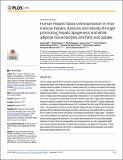Por favor, use este identificador para citar o enlazar a este item:
http://hdl.handle.net/10261/177172COMPARTIR / EXPORTAR:
 SHARE SHARE
 CORE
BASE CORE
BASE
|
|
| Visualizar otros formatos: MARC | Dublin Core | RDF | ORE | MODS | METS | DIDL | DATACITE | |

| Título: | Human hepatic lipase overexpression in mice induces hepatic steatosis and obesity through promoting hepatic lipogenesis and white adipose tissue lipolysis and fatty acid uptake |
Autor: | Cedó, Lídia; Santos, David; Roglans, Núria; Julve, Josep; Pallarès, Victor; Rivas-Urbina,Andrea; Llorente-Cortés, Vicenta CSIC ORCID; Laguna, Joan Carles; Blanco-Vaca, Francisco; Escolà-Gil, Joan Carles | Fecha de publicación: | 15-dic-2017 | Editor: | Public Library of Science | Citación: | PLoS ONE 12(12): e0189834 (2017) | Resumen: | Human hepatic lipase (hHL) is mainly localized on the hepatocyte cell surface where it hydrolyzes lipids from remnant lipoproteins and high density lipoproteins and promotes their hepatic selective uptake. Furthermore, hepatic lipase (HL) is closely associated with obesity in multiple studies. Therefore, HL may play a key role on lipid homeostasis in liver and white adipose tissue (WAT). In the present study, we aimed to evaluate the effects of hHL expression on hepatic and white adipose triglyceride metabolism in vivo. Experiments were carried out in hHL transgenic and wild-type mice fed a Western-type diet. Triglyceride metabolism studies included β-oxidation and de novo lipogenesis in liver and WAT, hepatic triglyceride secretion, and adipose lipoprotein lipase (LPL)-mediated free fatty acid (FFA) lipolysis and influx. The expression of hHL promoted hepatic triglyceride accumulation and de novo lipogenesis without affecting triglyceride secretion, and this was associated with an upregulation of Srebf1 as well as the main genes controlling the synthesis of fatty acids. Transgenic mice also exhibited more adiposity and an increased LPL-mediated FFA influx into the WAT without affecting glucose tolerance. Our results demonstrate that hHL promoted hepatic steatosis in mice mainly by upregulating de novo lipogenesis. HL also upregulated WAT LPL and promoted triglyceride-rich lipoprotein hydrolysis and adipose FFA uptake. These data support the important role of hHL in regulating hepatic lipid homeostasis and confirm the broad cardiometabolic role of HL. | Versión del editor: | https://doi.org/10.1371/journal.pone.0189834 | URI: | http://hdl.handle.net/10261/177172 | DOI: | 10.1371/journal.pone.0189834 | E-ISSN: | 1932-6203 |
| Aparece en las colecciones: | (IIBB) Artículos |
Ficheros en este ítem:
| Fichero | Descripción | Tamaño | Formato | |
|---|---|---|---|---|
| Human_Cedo.pdf | 1,23 MB | Adobe PDF |  Visualizar/Abrir |
CORE Recommender
PubMed Central
Citations
9
checked on 14-abr-2024
SCOPUSTM
Citations
19
checked on 15-abr-2024
WEB OF SCIENCETM
Citations
19
checked on 26-feb-2024
Page view(s)
195
checked on 19-abr-2024
Download(s)
172
checked on 19-abr-2024

